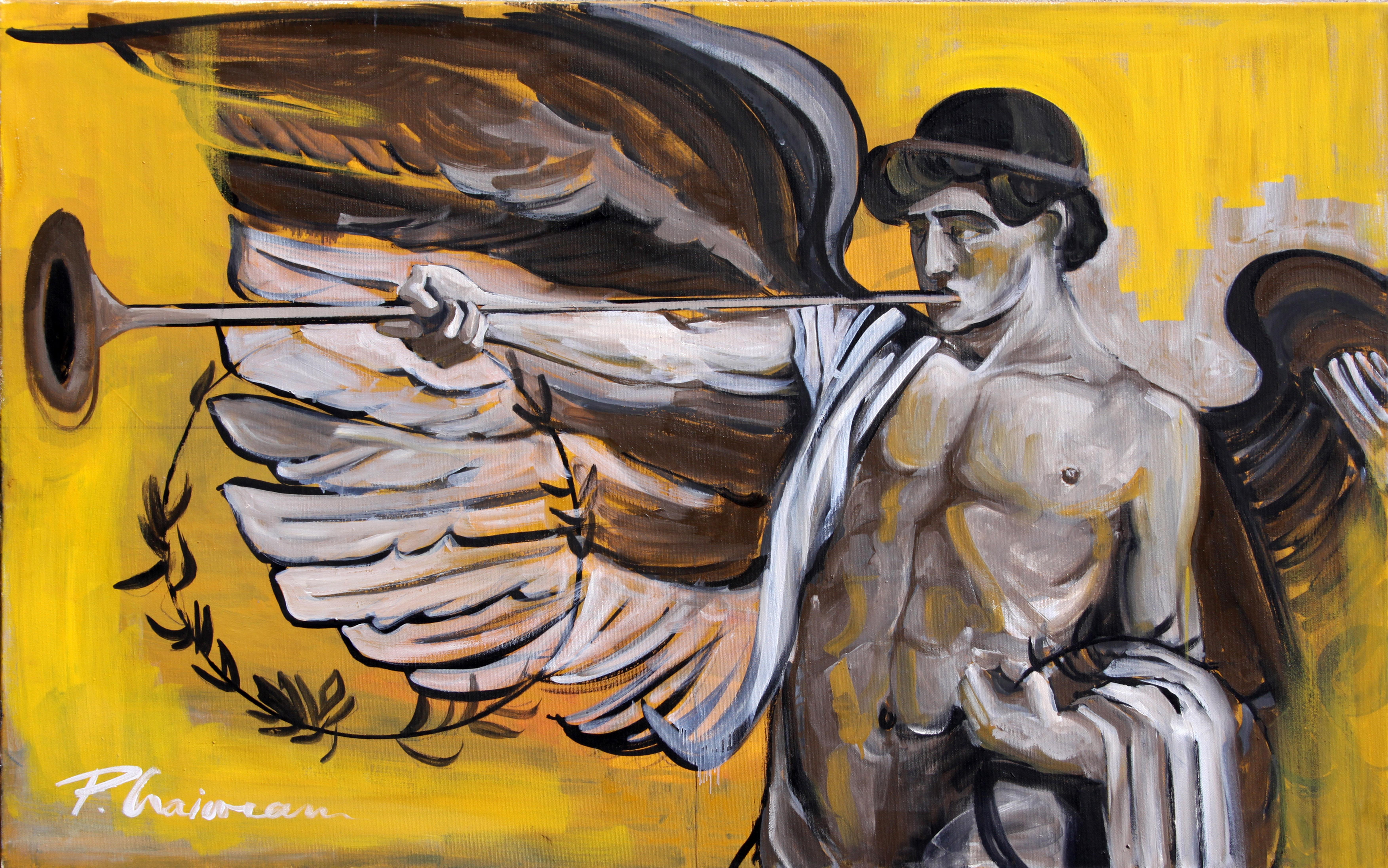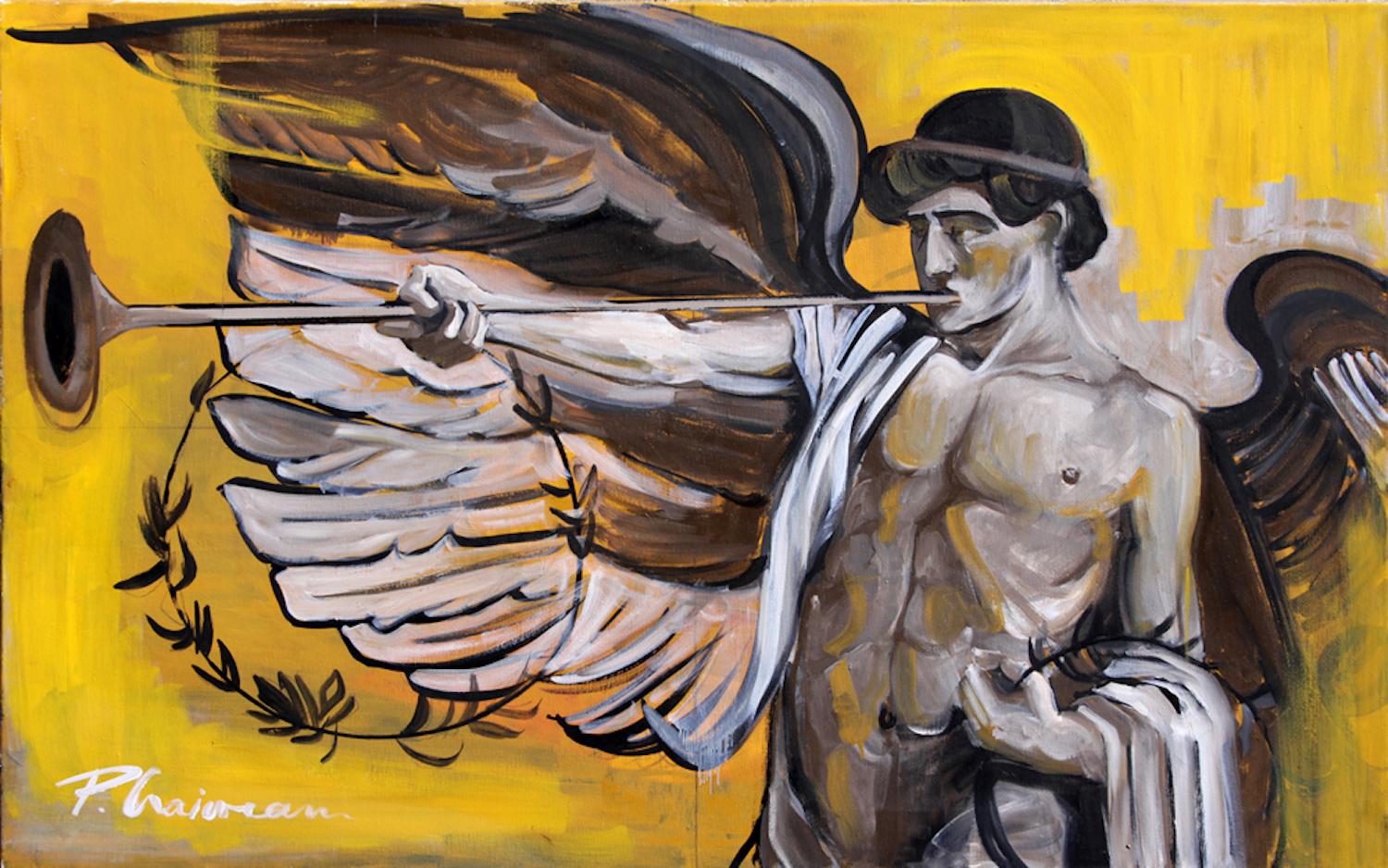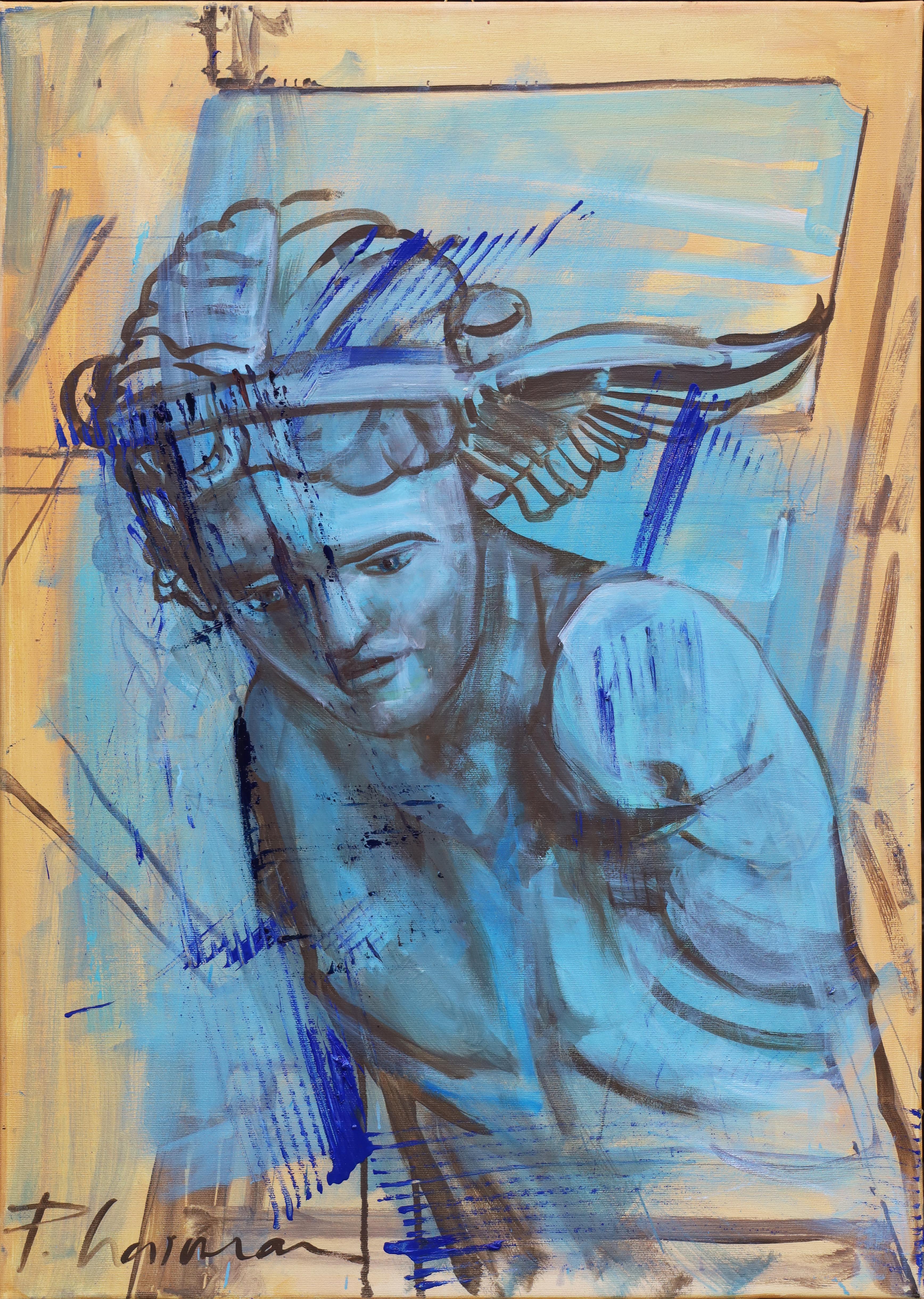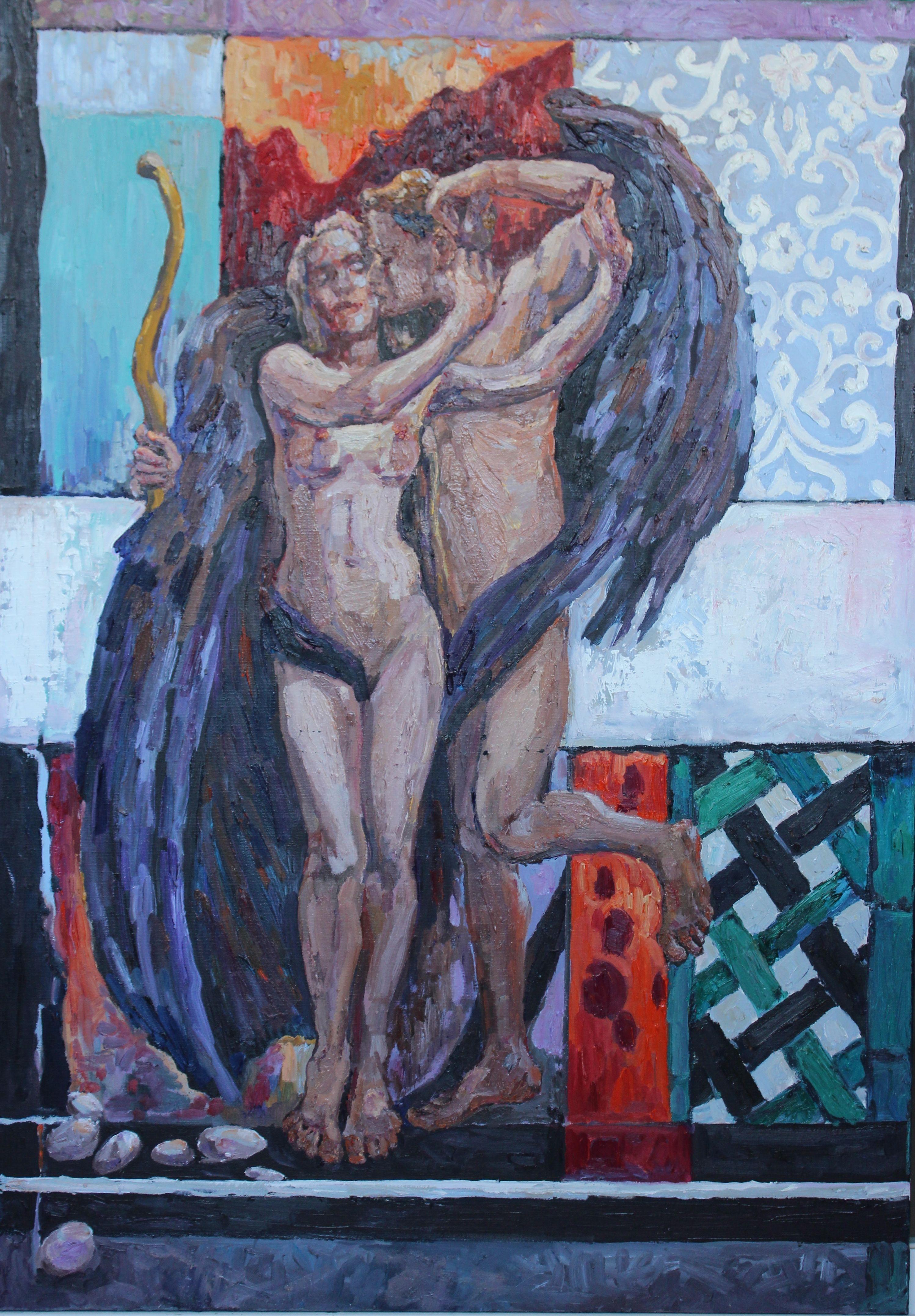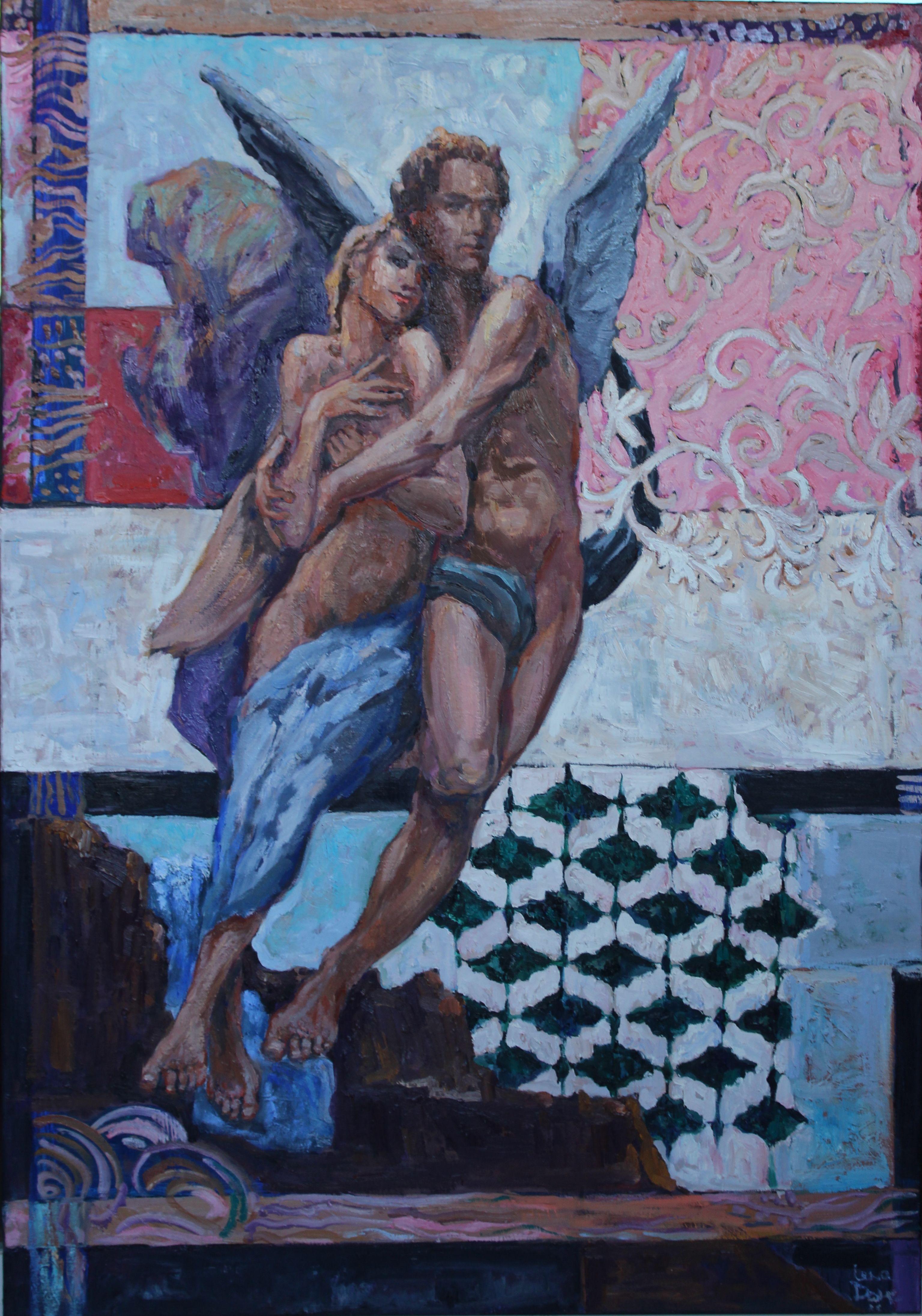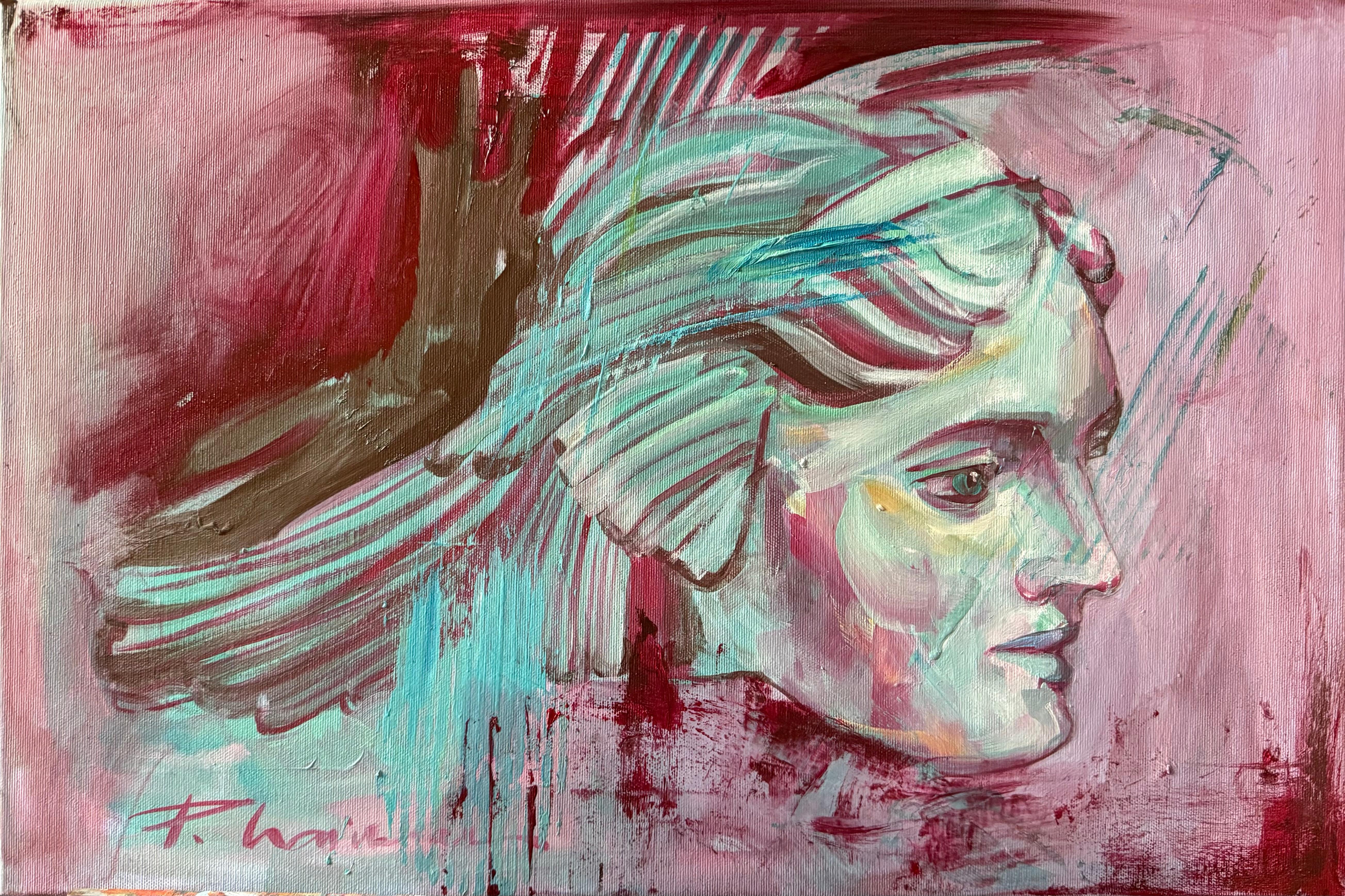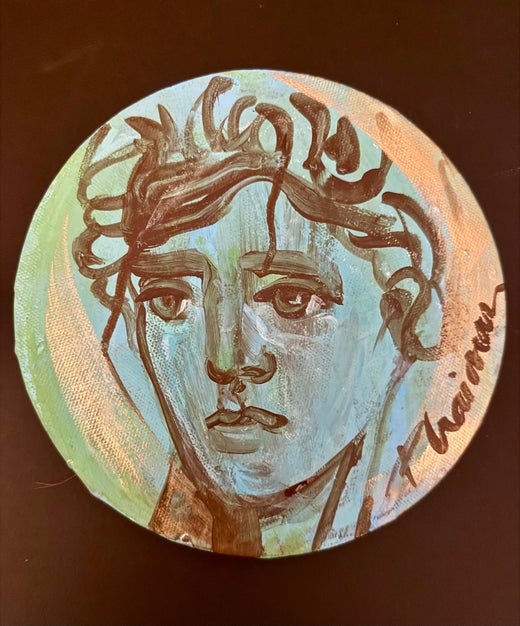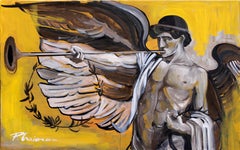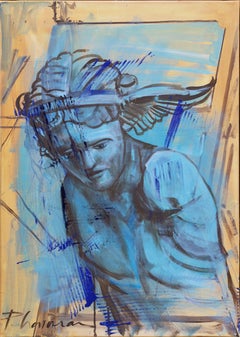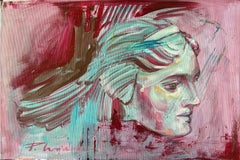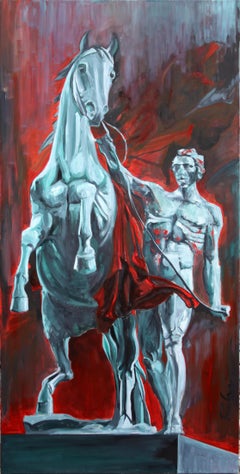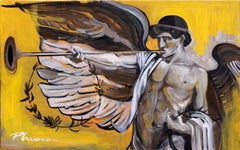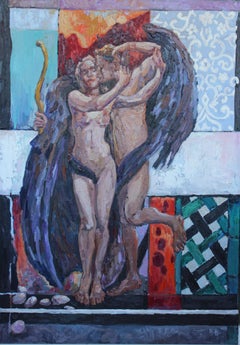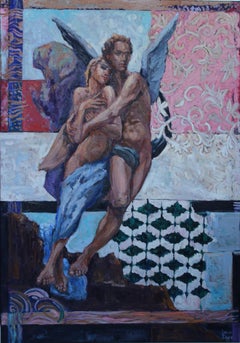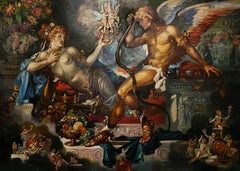Items Similar to Zeus and Ganymede - Paula Craioveanu oil canvas Neo Mythology
Want more images or videos?
Request additional images or videos from the seller
1 of 5
Paula CraioveanuZeus and Ganymede - Paula Craioveanu oil canvas Neo Mythology2103
2103
$2,400
$3,00020% Off
£1,870.07
£2,337.5820% Off
€2,121.53
€2,651.9220% Off
CA$3,449.34
CA$4,311.6720% Off
A$3,798.05
A$4,747.5720% Off
CHF 1,969.46
CHF 2,461.8220% Off
MX$44,979.41
MX$56,224.2720% Off
NOK 25,001
NOK 31,251.2520% Off
SEK 23,366.27
SEK 29,207.8420% Off
DKK 15,845.33
DKK 19,806.6720% Off
About the Item
"Zeus and Ganymede", oil and silver leaf on canvas, 39x39in / 100x100cm
Inspired by the legend of Zeus and Ganymede.
Part of my NeoMythology project.
Shipped as it is, stretched.
"Zeus and Ganymede" is one of the most well-known stories from Greek mythology. The myth of Zeus and Ganymede involves Zeus abducting the mortal Ganymede, a beautiful Trojan youth, to serve as his cupbearer and companion on Mount Olympus. This tale has been interpreted in various ways throughout history, touching on themes of divinity, beauty, immortality, and power dynamics.
Zeus takes the form of a winged Minotaur. By merging the Minotaur’s primal, animalistic power with Zeus’s divine authority, the artist might be highlighting Zeus’s dual nature. He is both majestic and domineering, capable of beauty and violence. The bull’s head is also a nod to Zeus’s frequent association with bulls, such as in his transformation into a bull to abduct Europa. The wings recall Zeus’s form as an eagle in the myth, symbolizing his ability to transcend earthly limits and ascend to the heavens. Here, the wings also imply Zeus’s role as a higher, godlike figure who takes Ganymede from the mortal world into the divine realm.
The mortal figure below represents Ganymede, the object of Zeus’s divine attention. His pose, gazing upward, conveys both vulnerability and awe, reflecting his mortal limitations in the face of divine power. The scroll in Ganymede’s hand symbolizes human knowledge, culture, or the written record of myths. Its inclusion suggests that Ganymede represents not just individual beauty but humanity’s intellectual and creative aspirations. Zeus’s abduction of Ganymede might then symbolize the gods’ appropriation of humanity’s finest qualities.The red cloth surrounding Ganymede evokes passion, desire, and vitality. It underscores the intensity of Zeus’s gaze upon him and heightens the emotional and sensual undertones of the scene. Drapery also has classical connotations, often used in art to signal importance and elevate figures to near-divine status.
Ganymede’s upward gaze and relaxed posture reflect submission, curiosity, or even an invitation, symbolizing his acceptance of his role as a mortal being elevated to Olympus.
The tension between the figures is the central dynamic of the painting. Zeus dominates the composition, soaring above Ganymede and taking up the majority of the space. This reinforces the power imbalance inherent in the myth. However, Ganymede’s unguarded, open posture suggests a willingness to embrace his divine destiny. The upward gaze of Ganymede links the mortal and divine realms, bridging the earthly and the celestial. This connection symbolizes humanity’s longing for transcendence, beauty, and eternal significance.
The swirling black patterns that decorate the metallic background evoke a sense of the otherworldly and the eternal. These patterns recall the labyrinth associated with the Minotaur, symbolizing complexity, mystery, and divine intervention. Their presence might suggest that Zeus’s pursuit of Ganymede is not merely physical but also part of a larger, intricate cosmic design. The patterns resemble celestial or astral designs, reinforcing the idea of the heavens and Olympus as the backdrop for this abduction. They also add a layer of decorative beauty, aligning with the myth’s emphasis on Ganymede’s unparalleled beauty.The reflective silver background situates the scene outside of time and space. The metallic surface suggests that this story exists in a divine, eternal realm, beyond the boundaries of the mortal world. The silver backdrop may also allude to Ganymede’s transformation into an immortal being on Olympus, where he serves as Zeus’s cupbearer. This elevation from mortality to immortality is one of the key themes of the myth. The painting explores the myth’s themes of power and desire with bold visual language.
The painting captures the intense physicality and sensuality of Zeus’s pursuit, with the powerful form of the winged Minotaur looming over the delicate, contemplative Ganymede. This emphasizes the imbalance of power and the divine desire for mortal beauty. In myth, Zeus’s abduction is both a violation and an honor, as Ganymede is granted eternal youth and beauty. The painting captures this tension—between submission and elevation, mortality and divinity.
The painting communicates both reverence and critique.It reveres the myth’s grandeur and emotional depth, portraying Zeus’s transformative power and Ganymede’s role as a symbol of beauty and human potential. At the same time, the depiction of Zeus as a Minotaur with wings adds an ambiguous tone, highlighting the predatory and overwhelming nature of divine desire.
"Zeus and Ganymede," becomes an exploration of humanity’s relationship with the divine. Zeus’s hybrid form emphasizes the duality of his power—majestic yet animalistic, celestial yet primal. Ganymede represents mortal beauty, intellect, and the human longing for transcendence, while the metallic background and ornamental patterns reinforce the myth’s timeless and eternal significance. The artist’s interpretation invites us to reflect on themes of power, submission, and the pursuit of immortality, presenting the myth in a way that is both modern and deeply rooted in classical storytelling.
Biography:
Paula Craioveanu is a Romanian artist, born in 1976. She grew up surrounded by art and inspiration, in a family of artists. Trained in Bucharest and New York as an architect and painter. Holds a degree in Architecture and a PhD in Visual Arts. Presently working as a full-time artist.
At the age of 16, Paula Craioveanu moved to New York, where she came in contact with New York’s vibrant art scene, she graduated from high school and then studied at Parsons School of Design. Then she moved back to Romania where she studied for the next 6 years at the Architecture University in Bucharest and graduated with a degree in Architecture in 2000. In 2013 she earned a Ph.D in Visual Arts at the University of Arts in Bucharest with the theme “Geometry of Space in 17th century Dutch painting”. After this, she dedicated her full time to art, and showed her talent to the art world.
Paula Craioveanu works in acrylic and oil paints, but also pen and ink or tempera works on paper. She regularly participates in shows and exhibitions in galleries along the East and West Coast of the United States, like bG Gallery Santa Monica, Dacia Gallery and Perseus Gallery in New York.
Paula Craioveanu’s work is featured on the two most exclusive online art marketplaces, 1stDibs and Artsy.
Over the course of 20 years, Paula Craioveanu has created several painting series: “Abstract”, “Interiors”, “Nude in Interior”, “NeoMythology”. Paula Craioveanu’s work has been placed in private collection around the world, both in Europe and in the United States.
Today, Paula Craioveanu has set up studios and works in Bucharest and New York.
Find original Paula Craioveanu paintings, works on paper and other art on 1stDibs.
Next: Works on display - December 2024, Context Art Miami.
- Creator:Paula Craioveanu (1976, Romanian)
- Creation Year:2103
- Dimensions:Height: 39 in (99.06 cm)Width: 39 in (99.06 cm)Depth: 1 in (2.54 cm)
- Medium:
- Movement & Style:
- Period:
- Condition:
- Gallery Location:Forest Hills, NY
- Reference Number:Seller: Romanian-American artist. PhD in Visual Arts.1stDibs: LU2240213987882
Paula Craioveanu
Trained in Bucharest and New York as architect and painter. Holds a degree in Architecture and a PhD in Visual Arts. Presently working as a full-time artist.
About the Seller
5.0
Vetted Professional Seller
Every seller passes strict standards for authenticity and reliability
Established in 2000
1stDibs seller since 2022
14 sales on 1stDibs
Typical response time: 9 hours
- ShippingRetrieving quote...Shipping from: Bucureşti, Municipiul Bucureşt, Romania
- Return Policy
More From This Seller
View AllWINGED GENIUS- original painting by Paula Craioveanu Neo Mythology
By Paula Craioveanu
Located in Forest Hills, NY
"Winged Genius", oil on canvas, 70x110cm, 27.5×43.5in
Winged Genius is a fantastic character, a mythological creature, a male figure with birds’ wings, a guardian spirit, a demigod.
...
Category
2010s Academic Figurative Paintings
Materials
Oil
$4,000 Sale Price
20% Off
Hypnos God of Sleep #1 signed Paula Craioveanu oil on canvas Neo Mythology
By Paula Craioveanu
Located in Forest Hills, NY
"Hypnos God of Sleep #1", oil on canvas, 27.5x19.68in / 70x50cm
Hypnos is the personification of sleep, the god who touches humans with his wings , his mission is to help people slee...
Category
2010s Post-Modern Figurative Paintings
Materials
Canvas, Oil
$1,020 Sale Price
40% Off
Hypnos 2 God of Sleep signed Paula Craioveanu oil on canvas
By Paula Craioveanu
Located in Forest Hills, NY
"Hypnos 2", oil on canvas, 15.74x23.6in / 40x60cm
Hypnos is the personification of sleep, the god who touches humans with his wings. His mission is to help people sleep. Part of New...
Category
2010s Post-Modern Figurative Paintings
Materials
Canvas, Oil
$1,600 Sale Price
20% Off
The Horse Tamer - original painting by Paula Craioveanu - Neo Mythology Hero
By Paula Craioveanu
Located in Forest Hills, NY
The Horse Tamer, oil on canvas, 200x100cm/ 79x39in. Shipped rolled in a tube, anywhere in the world. Comes with a certificate of authenticity, signed by the artis
The horse tamer, i...
Category
2010s Figurative Paintings
Materials
Oil, Canvas
Amazon - original painting on round canvas Paula Craioveanu Neo-Mythology
By Paula Craioveanu
Located in Forest Hills, NY
Inspired by the mythological Greco-Roman origins, these works of art are dreamlike superimposed views of expressive and sometimes sensual figures.
Like the immortal mythological hero...
Category
2010s Surrealist Figurative Paintings
Materials
Acrylic
THE FRESCO - original large oil canvas painting by Paula Craioveanu
By Paula Craioveanu
Located in Forest Hills, NY
"The Fresco"
Oil on canvas
Large original, one-of-a-kind, painting - 33.5x63in / 85x160cm
Nude in a Italian Baroque interior, with blue marine painted fresco.
Picture from the sol...
Category
2010s Contemporary Landscape Paintings
Materials
Canvas, Oil
$1,800 Sale Price
40% Off
You May Also Like
Winged Genius
By Paula Craioveanu
Located in Santa Monica, CA
Oil on canvas.
Category
21st Century and Contemporary Contemporary Portrait Paintings
Materials
Canvas, Oil
$3,200 Sale Price
20% Off
Amour& Psyche II., Painting, Oil on Canvas
By Elena Done
Located in Yardley, PA
There were once a king and queen, rulers of an unnamed city, who had three daughters of conspicuous beauty. The youngest and most beautiful was Psyche, It was rumored that she was th...
Category
2010s Art Deco Paintings
Materials
Oil
Amour & Psyche III, Painting, Oil on Canvas
By Elena Done
Located in Yardley, PA
The legend of Cupid and Psyche ( 2nd century AD by neoplatonic Apuleos) concerns the overcoming of obstacles to the love between Psyche ("Soul" or "Breath of Life" or “Animaâ€
Category
2010s Art Deco Paintings
Materials
Oil
Cupid and Psyche, Classic Art, Original oil Painting, Ready to Hang
Located in Granada Hills, CA
Artist: Alexander Litvinov
Work: Original oil painting, handmade artwork, one of a kind
Medium: Oil on Canvas
Style: Classic Figurative
Year: 2003
Title: Cupid and Psyche
Size: 20" ...
Category
2010s Impressionist Figurative Paintings
Materials
Canvas, Oil
Amour & Psyche -I, Painting, Oil on Canvas
By Elena Done
Located in Yardley, PA
The legend of Cupid and Psyche There were once a king and queen, who had three daughters of conspicuous beauty. The youngest and most beautiful was Psyche, It was rumored that she ...
Category
2010s Art Deco Paintings
Materials
Oil
The Mysterious flame of Anima 8, Painting, Oil on Canvas
By Danko Merin
Located in Yardley, PA
This androgenic characteristic of our being can be observed from different perspectives of the mind and body. Art and artists are not the outsiders of this need for displaying and de...
Category
2010s Modern Paintings
Materials
Oil
More Ways To Browse
The Minotaur
Zeus Painting
Odd Nerdrum
Oil Painting Antique Pre 1900 Art
Oil Paintings Woman White
Soho Nyc
Unknown Russian Painting
Alabama Artist
Dutch Girl
Jean Renoir
Mexican Expressionist
Oil Painting 18 Century
Oil Painting Little Girl
Oil Paintings 70 X 55
Ophelia Art
Painter Walker
Shalom Of Safed
Venezuela Painting
